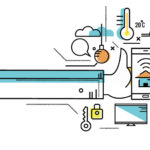Key technologies for 2017
2016 have brought a quantum leap for society in the adoption of new technologies. Slowly but surely biometrics, virtual reality, domotics and cryptocurrencies are making inroads in consumers' daily activities, and many of the advances predicted in "Back to the future" are now a reality. What's in store in 2017?

Domotics to the fore
The house of the future is coming closer. It's now possible to control light bulbs, washing machines, thermostats, blinds, locks and coffee machines with a single click. Control by smartphones is almost total provided they have an Internet connection, and we're already seeing wireless standards such as Thread, from Samsung, and Nest, to connect all our household devices. Apple has also jumped on the bandwagon with its Home app, intended to make use of the Internet of Things in the home.
And these innovations are also transforming our kitchens. Last September at the IFA technology fair in Berlin, Panasonic presented smart cookers that know what temperature to cook food at, and interactive wine cellars that know what's inside them and show through a digital glass door what to serve with that bottle of wine that's been lurking in there for years.
IKEA's proposal features the kitchen of the future for 2025, with an innovative food recognition system on a wooden board (an overhead camera detects what's placed on the surface), allowing users to see recipes, tips, additional product information and so on.
Voice power
VCA is also shaping up to be key for artificial intelligence and voice assistants. Last November the consultants Gartner published a series of very favorable forecasts for this type of technologies: in 2020, 30% of web browser sessions will take place without a screen, accessing information only by means of voice interaction.
Siri, Google Now, Cortana and the improved accuracy of devices such as Amazon's Echo or HomeKit will make it possible to shop online, choose music, order food or make a transfer with only a voice command. Some assistants go beyond the realms of science fiction, such as Jibo, christened as the first social robot, an all-rounder that recognizes faces, voices and can help with any domestic chore.
Massive virtual reality
The success of Pokemon Go has confirmed that augmented (AR) and virtual reality (VR) are here to stay. The lines between the digital and physical world are gradually blurring and generating new business opportunities, as noted by Gartner in a study on trends for 2017. Virtual and augmented reality will largely transform individuals' ways of interacting with each other and with their environment and software systems, and over time, their uses could go well beyond visual immersion to include all our senses.
In addition to their application to video games, the popularity of AR and VR may open the doors to gamification in the workplace. Gamification will play a key role in business strategy next year, along with customer experience in the use of big data, in managing customers' preferences. Amazon, Netflix and Spotify are already using algorithms to predict which products may interest their users.
3D printing –more social than ever
Although this invention has been on the market for several years, 3D printing stood out as one of the most innovative fields of 2016. Building houses in less than 24 hours? This is now possible now thanks to WinSun, a Chinese company that produces earthquake-proof housing. And it's not only Chinese companies that are using this technique. The first pedestrian bridge in the world using 3D printing has been built in the city of Alcobendas in Madrid.
Medicine has also benefited from technology. In early 2016, scientists from the United States implanted structures of living tissue manufactured with a 3D bioprinter in animals, as reported by the journal Nature.
The experts printed several types of tissue –cartilage, bone and muscle– and implanted them in mice, developing a system of blood vessels. Although this is still in an experimental phase, it is an important step forward on the road towards manufacturing spare tissue for human patients. In another noteworthy development, last December 2 the Clínica Universidad de Navarra implanted a totally artificial heart in what is certainly an encouraging milestone for the years ahead.
The technique has also been applied to food. NASA was the first to adopt 3D printing to produce food, an idea that has been marketed by the company Food Ink. For example, the restaurant Yours in Barcelona presented futuristic set menus with compositions printed with this technology.
Other gadgets that will make our lives easier
The company Waverly Labs has developed the earpiece translator, consisting of two headphones connected to your cellphone with an app, through which you can choose the two languages to be translated. The devices will instantly translate all the conversations you may have. Panasonic has also developed a megaphone that instantly translates what you say into several languages.
Nike was the first to launch the self-adapting trainers imagined in the film Back to the future. The footwear in question, the HyperAdapt 1.0., has an algorithm to measure pressure, so when you press with your foot, the laces tie themselves. The pressure itself can be modified by means of buttons with LEDs on the tongue.